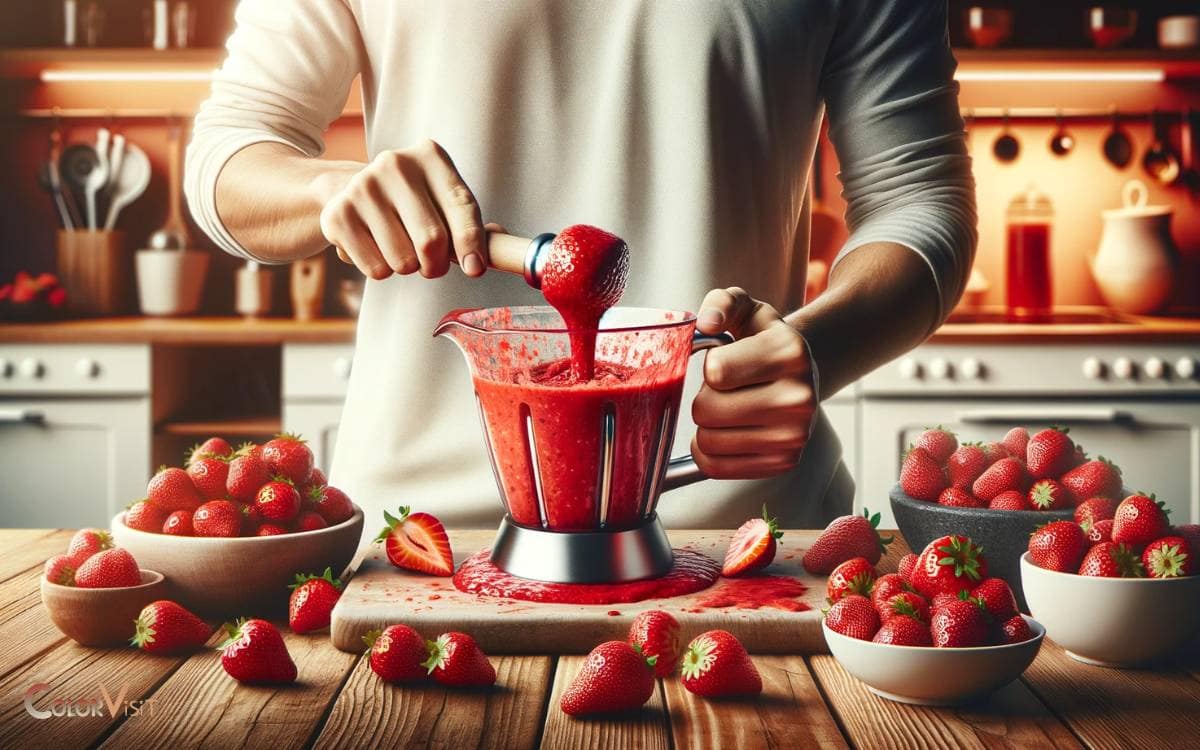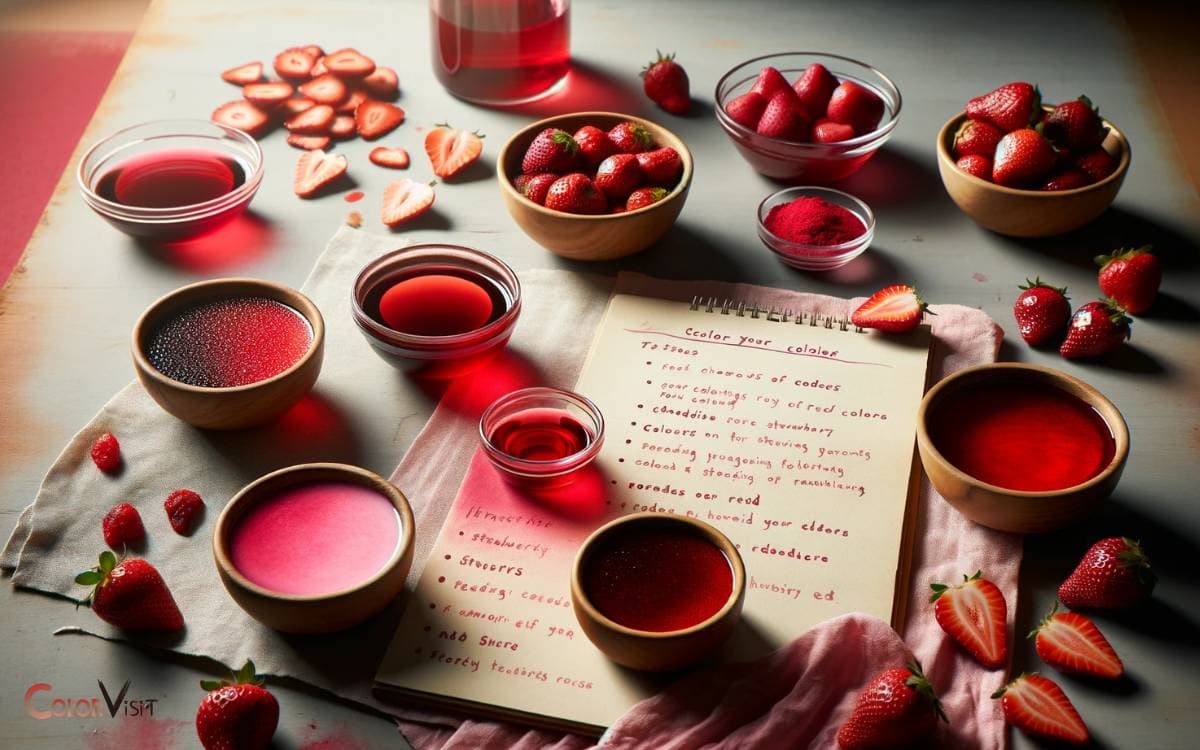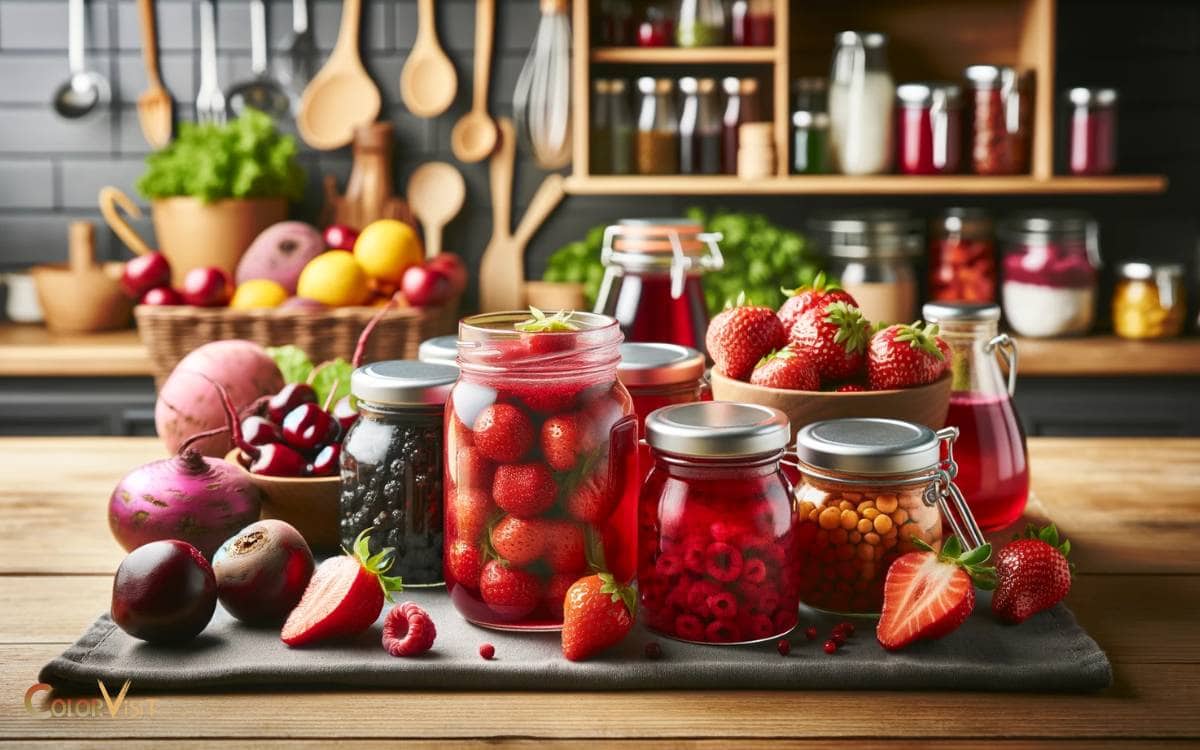How to Make Red Food Coloring from Strawberries? 5 Steps!
Creating natural red food coloring from strawberries is a simple and effective way to bring a splash of color to your culinary projects without the use of artificial dyes.
This juice can be reduced over low heat to intensify the color and thicken the liquid into a concentrated dye.
The process involves:
Unlock the rich, natural color of strawberries for your baking and cooking endeavors with this straightforward method, and infuse your dishes with a homemade touch that’s both visually striking and free from artificial additives.
Key Takeaway
Step 1: Selecting the Right Strawberries
When selecting strawberries for making red food coloring, choose ripe, firm berries without any signs of mold or bruising.
- Ripe strawberries contain the highest concentration of natural pigments, essential for creating vibrant red food coloring.
- It is crucial to use firm strawberries, as softer ones are more likely to have begun the decomposition process, which can alter the color and quality of the dye.
- Additionally, any mold or bruising on the berries can introduce unwanted microorganisms that may affect the stability and safety of the food coloring.
By selecting the right strawberries, the resulting food coloring will be rich in natural pigments, ensuring a high-quality and innovative alternative to synthetic dyes.
Step 2: Preparing the Strawberries for Extraction
To begin the process of extracting red food coloring from strawberries, carefully wash and hull the ripe berries.
- Start by rinsing the strawberries under cold running water to remove any dirt or debris. Gently pat them dry with a paper towel to ensure they are clean and free of moisture.
- Next, remove the green hulls from the strawberries using a paring knife or a specialized hulling tool.
- Take care to remove the hulls without sacrificing too much of the flesh, as the color is concentrated in the fruit.
- Once the strawberries are washed and hulled, they are ready for the extraction process to obtain the natural red food coloring.
This meticulous preparation ensures the purity and quality of the final product.
Step 3: Extracting the Red Pigment From Strawberries
The extraction of the red pigment from strawberries involves a delicate process to isolate the natural coloring compound.
- The first step is to crush the strawberries into a fine pulp, breaking down the cell walls to release the pigments.
- Then, the pulp is transferred to a container and mixed with a solvent such as ethanol, which helps dissolve the pigments.
- This mixture is left to macerate for a period of time, allowing the solvent to extract the red pigments from the strawberries.
- After maceration, the mixture is filtered to remove any solid particles, leaving behind a solution rich in red pigments.
This solution can then be further processed to obtain a concentrated red food coloring.
Step 4: Filtering and Storing the Red Food Coloring
After the maceration process, the solution rich in red pigments is carefully filtered to remove any remaining solid particles.
- The filtered solution is passed through a fine mesh or cheesecloth to separate any solid particles from the liquid.
- This ensures that the red food coloring is free from any impurities that could affect its quality and appearance.
- After filtering, the red food coloring should be stored in a dark, cool place to prevent degradation of the pigments due to light exposure.
- It is advisable to use an airtight, light-resistant container to maintain the color’s vibrancy over time.
Properly filtered and stored red food coloring can have a shelf life of several weeks to a few months, depending on storage conditions and the freshness of the strawberries used.
Step 5: Using the Homemade Red Food Coloring in Recipes
Utilize the homemade red food coloring derived from strawberries to enhance the vibrancy and natural appeal of various culinary creations.
By incorporating this natural coloring agent into recipes, you can avoid artificial additives while adding a pop of red color.
Below is a table showcasing some recipe ideas where you can use the homemade red food coloring:
| Recipe Type | Examples |
|---|---|
| Baking | Red velvet cupcakes, strawberry swirl cheesecake |
| Beverages | Strawberry lemonade, raspberry smoothie |
| Frosting | Cream cheese frosting, strawberry buttercream |
| Desserts | Strawberry mousse, raspberry macarons |
| Breakfast | Strawberry pancakes, mixed berry waffles |
Tips for Achieving Different Shades of Red
To achieve different shades of red when making food coloring from strawberries, there are several factors that can be adjusted. Varying the concentration of fruit used can impact the intensity of the color.
Additionally, adjusting the pH levels of the mixture by adding acidic or alkaline ingredients can influence the final shade of red obtained.
Varying Fruit Concentrations
By experimenting with varying concentrations of strawberries, you can achieve a spectrum of red shades suitable for different culinary applications.
To achieve different shades of red food coloring, consider the following:
- Increased Concentration: Using a higher quantity of strawberries in the extraction process will result in a deeper, more intense red color. This is ideal for applications requiring a bold red hue, such as vibrant red frostings or cake batters.
- Dilution: Diluting the strawberry extract with water or a clear, flavorless liquid can create lighter shades of red. This is useful for achieving pastel tones in delicate desserts or for tinting beverages.
- Layering and Mixing: Experiment with layering and mixing different concentrations of the strawberry extract to create custom shades that perfectly complement specific dishes or baked goods.
Adjusting Ph Levels
When adjusting the pH levels of the strawberry extract, you can manipulate the red shades obtained from the varying concentrations, thus providing a wider range of options for culinary applications.
- By increasing the acidity, the red color tends to intensify, resulting in a brighter hue. On the other hand, by making the solution more alkaline, the red color becomes deeper and richer.
- The use of acidic ingredients, such as lemon juice, can help in achieving a more vibrant red, whereas adding a small amount of baking soda can lead to a darker, more burgundy shade.
- This ability to adjust the pH levels allows for a spectrum of red shades, catering to diverse aesthetic and culinary needs.
Utilizing Different Temperatures
One can achieve a range of red shades by utilizing different temperatures when making red food coloring from strawberries.
- Yields a lighter, more pinkish hue as the anthocyanin pigment is less extracted at lower temperatures.
- Produces a medium red color as the anthocyanin pigment is released more effectively at moderate temperatures.
- Results in a deeper, more vibrant red shade due to increased extraction of anthocyanin pigment at higher temperatures.
By carefully controlling the temperature during the extraction process, it is possible to obtain a spectrum of red shades, allowing for customization based on specific coloring needs.
Potential Substitutions and Storage Tips
Substitutions for strawberries in making red food coloring include cherries, raspberries, or pomegranates.
- These fruits contain natural pigments, such as anthocyanins, which impart a rich red color and can be used as alternatives for creating homemade food coloring.
- When making the coloring, it is important to consider the ratio of fruit to water to achieve the desired hue.
- Storing the homemade coloring in an airtight container in the refrigerator will help maintain its freshness.
- The cool temperature will slow down the degradation of the natural pigments, preserving the vibrancy of the red coloring.
It’s recommended to use the homemade red food coloring within a week for optimal freshness and color intensity.
Proper storage will ensure that the coloring remains suitable for various culinary applications.
Conclusion
By following the outlined steps for extracting red pigment from strawberries, one can create a natural and vibrant red food coloring.
By selecting the right strawberries and carefully preparing and filtering the extract, one can achieve the desired shade of red for various recipes.
Additionally, experimenting with different techniques and substitutions can result in a range of red hues.








